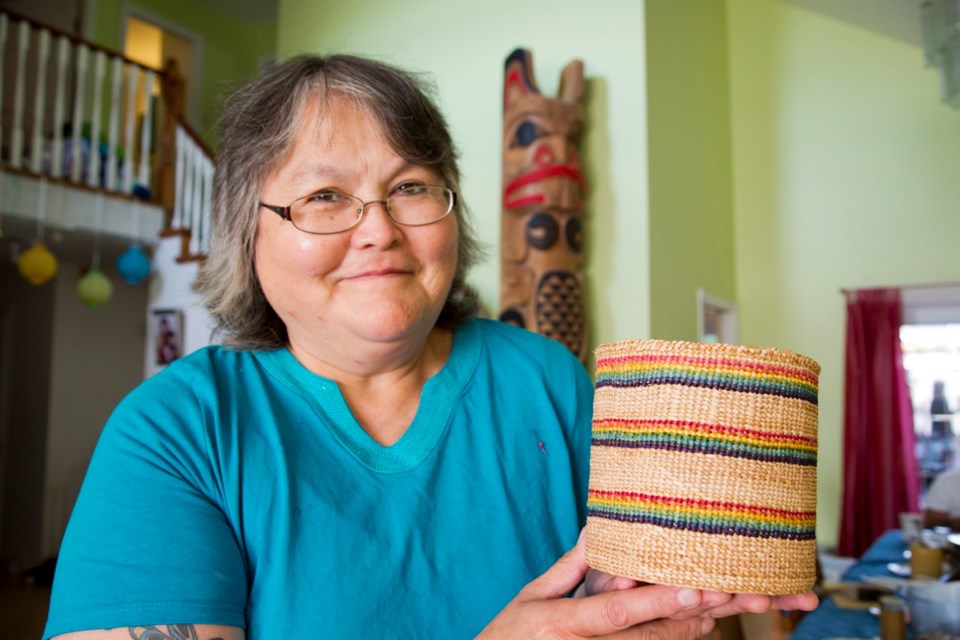 ‘Not long before she arrived on the Skeena, people of Kitwancool had brandished axes to drive off a party of surveyors. It hardly seems the place for a 56-year-old dumpling with a paint box.” From Laurie Carter, Emily Carr’s B.C. (Book Two) Northern B.C. and Haida Gwaii (Little White Publishing, Kelowna, 2016, 320 pp., $24.95).
‘Not long before she arrived on the Skeena, people of Kitwancool had brandished axes to drive off a party of surveyors. It hardly seems the place for a 56-year-old dumpling with a paint box.” From Laurie Carter, Emily Carr’s B.C. (Book Two) Northern B.C. and Haida Gwaii (Little White Publishing, Kelowna, 2016, 320 pp., $24.95).
When I discovered Laurie Carter’s first book about Emily Carr in B.C., I didn’t read it right away.
“Oh yeah,” I thought, “a matron with a pup-tent, following in the footsteps of Emily Carr. Probably with added tourist tips about Campbell River.” But soon after I took it up, I found myself swept along, travelling with Carter. When her second volume of the “travels with Emily Carr” series arrived in the mail, I started reading it right away, taking it up in spare moments to savour just one more adventure.
Before I read these books, I thought I knew a lot about Emily Carr, but really it was all a bit hazy. She’s just that crazy old lady who painted at Goldstream and up in the Queen Charlottes.
Carter’s first book gave me the details of the exact Vancouver Island locations the painter went to, and her comfortable writing is the perfect foil for a dazzling and pertinent array of quotes from Emily Carr. I recognized some of the Vancouver Island sites in Volume One, but this second volume is terra incognita for me: first B.C.’s Skeena and Nass territories, and then over to Haida Gwaii.
Carr, who was 56 years old in 1927, made her travels by steamship, sternwheeler and dugout canoe, carried from place to place like so much awkward luggage. Carter had the convenience of a camper van, coastal ferry service and the occasional splurge for a chartered boat and local guide.
No slouch in the research department, she mined all the written material by and about Carr — of which there is a lot — and sifted out relevant passages from her stories, diaries and letters. Leaping over Carr’s made-up names, missing locations and the free-floating chronology of her stories, Carter pops in the artist’s quotes at just the right moment in the journey, somehow making Carr’s words seem altogether new.
Carter’s books move along a path blazed by Susan Crean, whose book The Laughing One: A Journey to Emily Carr (Harper Fleming 2001) also offers field-trip visits to communities where Carr painted. Crean had engaged conversations with aware young native people and pursued probing lines of thought. By comparison, Laurie Carter is unabashedly a “travel writer.” Her books are not so deep. Nothing heroic is going to happen, and her references to diners and ferries will soon be dated. But in her breezy way, she takes us somewhere wonderful, in the company of Emily Carr.
Because of the costs involved in securing copyright to reproduce Carr’s paintings, Carter’s books are in black and white and sparsely illustrated, mostly with her own admirable photographs. Therefore, it is invaluable to have at hand Gerta Moray’s Unsettling Encounters (UBC Press, 2006). This is the baseline book on First Nations imagery in the art of Emily Carr. Moray deserves our gratitude for providing that basic text, with the lavish illustrations required by any Carr fan.
Carter creates straightforward character sketches of the people she meets, and brings us into the Nisga’a and Haida nations with respect and understanding. She makes friends with people, trusts them to take care of her, and receives as a treasured gift some hint of their very long history of doing things properly.
When she met carver John Bennett at Old Masset, he offered a nugget, in reference to the Haida reputation for long-distance sea travel: “When the eagle flies, it flaps its wings three times, then rests. That’s how Haida paddle, and they can paddle all day.”
On Haida Gwaii, Carter first headed north on Graham Island in her little car, and chartered a boat to take her to the northern tip. She came back to Skidegate a few years later and made her southern trip aboard the sailing ship Passing Cloud. The boat was “a fine example of classic elegance built for the long haul,” a happy Carter noted. With a biologist-captain and archeologist on board, they followed Carr everywhere.
In the 1840s, the Indian villages flourished suddenly, enriched by the sea otter trade. Then, after 1862, they were mown down by smallpox — 90 per cent of the population of Haida Gwaii died. The survivors were dragooned into work in the fisheries and canneries.
Carr went to see the remnants of that great world during her two visits in 1912 and 1927. A century later, Carter gives us pertinent facts about the new realities of the indigenous people and ecology with which Carr was so involved.
This book will lure you to visit this wonderful land. Carter is a strong supporter of local museums, for example the Nisga’a Museum at Laxgalts’ap: “I rarely use the word breathtaking, but it was.”
And everywhere she sees signs of new growth. She was looked after by the Haida Gwaii Watchmen (and women), a group of admirable men and women who stand tall, as stewards of their own magical sphere.
“Emily Carr remarked on the joy and privilege of being invited into the home of a First Nations family,” Carter wrote, “and I believe I know how she felt.”
Good subject. Good trip. Good writer.



